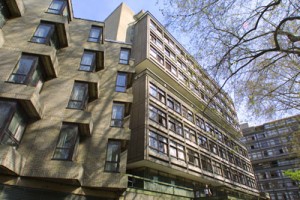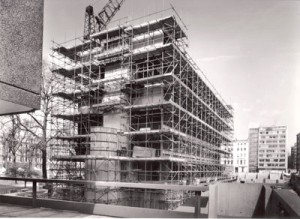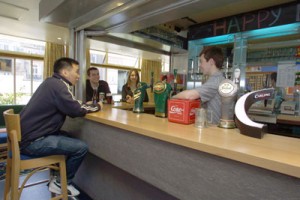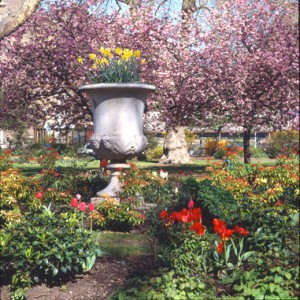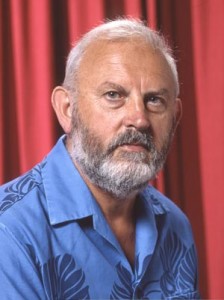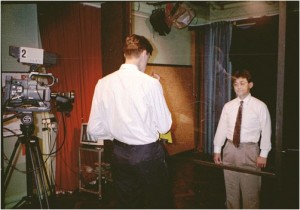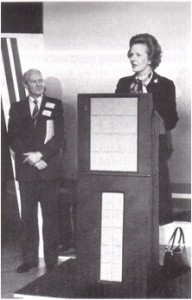
My involvement with the City and Guilds College (C&G) started during its centenary year in 1985. A week of celebrations were held (26 February – 1 March) and as part of that the Junior Common Room was transformed into an impressive exhibition called Tech2000. The exhibition was officially opened by the then Prime Minister Margaret Thatcher. Can you spot the famous handbag in the photo?
Besides making some 12 individual videos for various exhibits, an official video record of the week was also commissioned. This would capture the build-up, the opening and tour of the exhibits by the Prime Minister and the banquet held at the Guild Hall with the main speaker being HRH Prince Philip and this itself was not without its own problems. I was told in advance that we could not use too many lights when recording his speech because he didn’t like lights in his face.
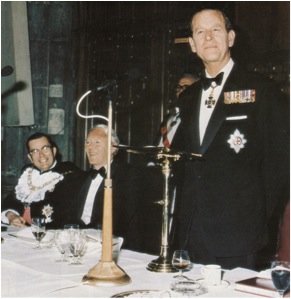
The problem was the size of the Guild Hall and the area we were trying to cover. Illumination within the hall was to be mostly from the candles on the tables, but this was far too low for our camera. A compromise was reached and we used a 2kw floodlight that would only be switched on moments before any one of the speeches started. Although this sounded good, we were located high up on a balcony some distance away, so the end result was better, but not great. It was also such a vast increase in light levels (compared to the candles) that actually switching the light on caused most of the people to turn around and look up at us! Although I’d requested a feed from the sound system to plug into our video recorder, I had not actually spoken with the engineers operating it on the night. Everything turned out OK and we received a cable with audio from the hall sound system. We were intending to video record most things, but our tapes would only run for 20 minutes at a time, so tape changes were going to have to be made. I was concerned that from an archives point-of-view we should not lose any of the speeches. I asked the engineer if he had been asked to make a sound recording of the whole evening, only to discover that no one had thought to do so! This was corrected and the tapes now reside in the college archive.
Let me just mention Prof Bruce Sayers (1928-2008) who was Dean of City and Guilds at the time. In fact he was Dean during the period 1984-1988 and again from 1991-1993. It was during his last period in office that Bruce commissioned the first video to be made showcasing City and Guilds – that was in 1993 with a second following in 1994 and a final in 1998. The 1993 video was more of an historical look-back at City and Guilds, with the further two looking more at the research work within the departments making up C&G. So, back to the C&G centenary and the video that covers the events making up the week. Hopefully it gives a flavour of what was happening within C&G and is also a wonderful snapshot of Imperial College life in 1985.
“City and Guilds, a celebration” was made in 1993. It was, as the title suggests, a celebration of C&G from its earliest times, right up to the date of making the video. We found some interesting photographs and film to help illustrate a commentary recorded by Bruce Sayers himself. We had previously discovered the film of the old City and Guilds building (1960), so we looked for more visuals that C&G alumni might remember. We achieved this with some film shot in 1928 of both “Sports Day” and “Morphy Day”. At that time, Sports Day was clearly still being held at the Stamford Bridge ground of Chelsea Football Club (this apparently being the case until the 1930’s). The film shows a lot more of sports day than we had time for in the video and this is something that I’ll feature in more detail in a later blog. You will see a couple of shots of the Queen’s Tower from a distance. These were from a hotel long since demolished. Located near Gloucester Road tube station the Forum Hotel had a number of floors almost equal to the Queen’s Tower in height. A simple phone call gained us access to their roof area and the result was some splendid views of London and the Queen’s Tower. Going back briefly to the 1960 film of the old guilds building it’s worth mentioning that this was an amazing discovery that was made after Sir Owen Saunders died in 1993. The 16mm colour film was found in his office drawer and passed to the college archivist who in turn asked me to see what it was! We’ll show that complete colour film in a later blog.
One person mentioned in that video was Herbert Cecil Booth (City and Guilds 1893) who invented the process of cleaning fabrics by sucking air through them. More can be seen on him in Tim Hunkin’s TV programme “The Secret Life of the Vacuum Cleaner“.
In 1994 we were asked to make a follow up which was to be called “City and Guilds College 1994 – an update”. This was very much a promotion for the research work being carried out within City and Guilds. It also included a section with Bob Schroter talking about the Old Centralian’s Trust fund, the charitable arm of the City & Guilds College Association. To give a flavour of the departments featured, research work was shown from Civil Engineering; Aeronautics; Electrical Engineering; Chemical Engineering to name but a few. Having just celebrated 10 years of operation, the Centre for Composite Materials showed their work relating to the aircraft industry, whilst Bio Mechanics demonstrated the work being carried out on knee joints. Again, this video’s audience was industry and alumni, particularly those overseas. Unlike the previous video, we commissioned a professional voice-over which was read by former BBC ‘Tomorrow’s World’ presenter Michael Rodd.
The final video made with Bruce Sayers for City and Guilds was in February 1998 and was entitled “City and Guilds: the challenges of tomorrow”. It makes reference that this was now 12 years into C&G’s second century and the fact that many changes were going on within Imperial College. In fact this video is a nice record of the South Kensington campus just a few years before major rebuilding works would change its appearance with: the new main entrance and Business School on Exhibition Road; Dalby Court and the (then) new Faculty Building.
For the very first time the City and Guilds Institute was mentioned and it’s connection with C&G explained. We went to their central London headquarters to get shots both outside and inside. Following on from this we shot at one of their lunches held each year at the college, which is attended by fellows of the C&G Institute and the Rector of Imperial. At the time of making the video the construction of the new Sir Alexander Fleming building was well into the completion stages and shots of both the initial building work and completed building were shown. Dame Julia Higgins, a former Dean of C&G, spoke about the many changes across the campus with the opening of the new SAF building and the intake of many new medical students.
The video ends by asking the question: “What would City and Guilds look like in 2025 and would those who know it now, recognise it then?”
Colin Grimshaw – January 2010 updated June 2021
